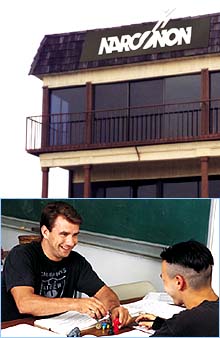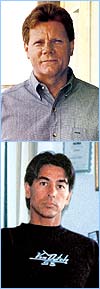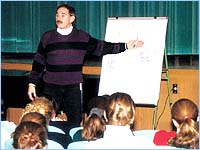

In all that has been said about losing the drug war, one Los Angeles group is winning it daily.

or 20 years, selling marijuana was the only job Gerry Marshall knew how to do. It came almost naturally to a boy who began smoking it at age 10. By age 12 he was drinking alcohol, by 18 he was using cocaine. At 21 he was part of the nightclub scene, regularly taking ecstasy and cocaine.
Gerry continued using drugs, and selling marijuana, until the time he was 30. Then a long-term relationship with his girlfriend began deteriorating rapidly, hitting bottom in late 1997 when she moved out.
“I started doing more and more drugs, trying to not feel bad about the breakup. But I finally fell apart over the whole thing — the relationship, the drugs — I was really depressed. The drugs and alcohol weren’t working anymore,” he said. “I was trying to quit them for a long, long time. I was never able to do it.”
Gerry was referred to the Narconon drug rehabilitation center as a program that could get him off drugs in all respects. “It was a hard decision to make,” Gerry recalled. “But I realized it was the only way out.”
Gerry started the Narconon program in June 1998 and graduated four months later. He has been clean and out of trouble ever since. “The program resolved a lot of issues that were making me use drugs in the first place,” he said. “There were many things I had to take responsibility for. I was able to get down to the bottom of the real problem. It was a real good experience for me personally.”
Overcoming Addiction
It was a similar, albeit ultimately more far-reaching, recovery from drug addiction that resulted in 1966 in the creation of the Narconon drug rehabilitation program, described by many as the most effective in the world. The late Willie Benitez, an addict and inmate in a state penitentiary in Arizona, found a book by author and humanitarian L. Ron Hubbard containing principles about life. Benitez corresponded extensively with Mr. Hubbard, and using principles from his books and guided by letters from the author, he overcame his addiction.
Benitez shared his experience with fellow inmates who were addicts. In a short time, Narconon — meaning literally “no drugs” — was established, using a range of Mr. Hubbard’s discoveries to address virtually all of the complexities of drug addiction. While Mr. Hubbard is well known as the founder of the Scientology religion, the Narconon program is autonomous and non-religious in nature. It has been supported from the outset by the Churches of Scientology and their members.
The Narconon program takes an average of four to six months to complete and is done in four phases including withdrawal and detoxification, communication skills to gain focus and self-control, restoration of personal ethics and values, and life skills that provide objective methods of dealing with any situation the drug-free individual may encounter.
Soon after its formation, Narconon records showed that more than 70 percent of addicts who completed the program returned to society as contributing members, and never looked back.
Likewise, Benitez and Narconon never looked back. With 106 centers in 31 countries today, Narconon has achieved international acclaim for rehabilitating close to 20,000 addicts, many hard-core, from drug and alcohol abuse.
“My Whole Life Changed”
One such Narconon center is in Newport Beach — officially known as Narconon Southern California — where Gerry Marshall overcame his drug addiction.
Formerly located on Los Angeles’s west side, the Narconon center was the first one to be opened outside of prison. In continuous operation since 1971, it is the oldest residential drug rehabilitation center of any organization in the Los Angeles area. Its 30 staff under Executive Director Larry Trahant service between 25 and 30 individuals on the program at any given time, or conduct drug education in the community. Hundreds have graduated the Narconon program at the center, including individuals from all over the United States.
Some of those graduates stay in LA and join the staff of Narconon. Among them is Patrick Lucarelli from Cleveland, Ohio.
In 1995, after serving six years in the U.S. Air Force, Patrick was working on his commercial pilot’s license while holding a job in his father’s nationwide business. Life was stable.
One day Patrick, who had never taken a drug, was in a car shop and a mechanic offered him crack cocaine. “I was always a very curious person,” he said. He smoked the crack later that night. “It was the greatest high I could ever imagine. Little did I know what I had just done,” he said.
Patrick next smoked crack several months later, then began binging over periods lasting two or three weeks. On one such drug binge, he disappeared for three days. When he surfaced, his family sent him to the first of a series of rehab programs.
After that first program, Patrick was straight for only two months. Then it was back to his drug habit. “That was life for the next three years,” Patrick said, in and out of rehab programs.
He lost count of how many rehab programs he tried. “At least a dozen,” he said. “I kept asking myself, ‘Why am I doing this to myself?’ I couldn’t find the answers.” Patrick saw a psychiatrist who diagnosed him as manic-depressive and prescribed him Prozac and Lithium, which he took for several days. “It was crap, totally wrong diagnosis,” he said. “Hang around someone addicted to a drug for a while and you’ll see wild mood swings. I needed to be off drugs, not on more of them.”
While living in Florida in early 1999, Patrick disappeared for two weeks on a binge after his wife left him. His father sent someone to find him and bring him back to Ohio. It was then that Patrick’s mother asked him if he remembered a book he read when he was in high school, called Dianetics. “She asked me if I knew the author also had a rehab program,” Patrick recalled. He remembered the book by L. Ron Hubbard, and thought, “‘Why not?’ I knew I had nothing to lose.”
Patrick flew to Los Angeles and started on the Narconon program. “As soon as I did, a lightbulb went on in my head. It was overnight,” he said. “The emphasis wasn’t ‘You’re a drug addict, and we’re going to show you how to cope with it.’ My whole life changed. The effects were monumental.”
...........................
“The program resolved a lot of issues that were making me use drugs in the first place. I was able to get down to the bottom of the real problem.”
...........................
|
|
The changes in Patrick’s life included finding a way to fulfill his desire to help others. “When I started the program I thought, ‘Okay, I’ll take care of my drug problem and go back with my life. But when I graduated, I thought, ‘I can’t turn my back on this.’” He wanted to help others get off drugs.
Patrick joined the staff of Narconon LA, where he serves as “Ethics Officer” — a position he said enables him to help recovering addicts in ways he never thought possible. Recovering addicts learn fundamental principles of personal ethics, enabling them to recognize and deal with situations in their lives — without turning to drugs. “Rehab has a great deal to do with ethics,” Patrick said. “It is all about the choices you make in life, about what you do in response to what life deals out, how you can actually change that.”
Drug Education: The Long Term Answer
Like Patrick, Gerry Marshall also felt he couldn’t turn his back on the program he feels saved his life. A year after graduating from the Narconon program, he returned to Narconon Southern California and joined its staff as the Director of Drug Education.
Gerry and fellow Narconon staff Tony Bylsma trained in Boston in the successful Narconon drug education program of another Narconon graduate, Bobby Wiggins.
As a former hard-core drug addict himself, Wiggins is the leading drug education specialist in the world-wide network of Narconon centers. Reduction of drug use of as much as 70 percent has been reported in some schools as a result of his drug education lectures. In response to demand, Wiggins has trained up scores of other lecturers and recorded his own lectures on video. The drug education has reached close to 1,000,000 students, as well as adults and groups overseas, including a lecture delivered by Wiggins in Britain’s House of Lords in 1997.
Working out of Tony’s Narconon drug education office in Glendale, Gerry and Tony lecture to an average of 300 students, mostly high school, each week.
“I have huge successes from the lectures personally, removing a lot of false ideas about drugs and replacing them with facts for these kids — about how they effect the mind, how they are stored in the body, and what they really do,” Gerry said. “With facts, these kids can make better decisions about drugs, and not just accept what other kids say because they don’t know better.”
The lectures gain the rapt attention of students. “We get asked by teachers all the time, ‘How do you get these kids to listen to you?’,” Gerry said. “But kids are in mystery to some degree about drugs. You fill in the blanks, and they’re very interested. And if a kid understands something, he’s less likely to have to experiment with it to know what it is.”
Surveys filled out by students after the lectures speak for themselves.
“My thoughts about drugs really did change, in the way that he explained the drugs, how they can affect you in many ways,” wrote one student after a lecture at Huntington Park High School.
“I don’t think that ‘e’ [ecstasy] is a good idea anymore,” wrote another from Cleveland High School. “I will always have [the lecture] in the back of my mind.”
“My [thoughts about drugs] changed in a way that I’m not going to do drugs,” wrote another. “I was planning to start. I’m never going to try drugs.”
Documented Results
While Narconon’s primary function is rehabilitation, drug education is considered the single most vital element in resolving the drug problem, reaching kids before they take drugs or become serious users.
“It is so much easier to prevent drug use than to stop it after being addicted,” Gerry said.
Although stopping isn’t easy, Narconon, with nearly 36 years of experience since the day it was formed, has rehabilitated thousands of drug and alcohol users from their addictions. The Narconon program is government funded in several foreign countries, and in the United States has been covered by most major insurance carriers.
Narconon has also gained a reputation for lowering drug-related crime, and a growing number of courts are sending drug offenders to do the Narconon program as an alternative sentence to prison.
As an indication of its continuing success, follow-up studies on graduates of Narconon’s largest drug rehabilitation facility, located in Oklahoma, found that between 69 and 72 percent remained drug-free two years after completion of the program.
While all Narconon centers deliver the same program, the Narconon in Oklahoma also serves as an international training center. As the facility’s previous location was consistently filled to capacity, in August 2001 it opened its new premises on 214 acres in Arrowhead State Park in the eastern part of the state. The new site — known as Narconon Arrowhead — is three times the size of the old location and capable of servicing hundreds of people at a time, making it one of the largest residential drug rehabilitation facilities in the world.
For those who have suffered through years of addiction with no answers and no hope until finding Narconon, that belief is an unshakable conviction.
For more information, contact Narconon Southern California — phone: (949) 675-8988 or
(800) 876-6378
e-mail: info@addiction.com
or visit www.addictionca.com
|








